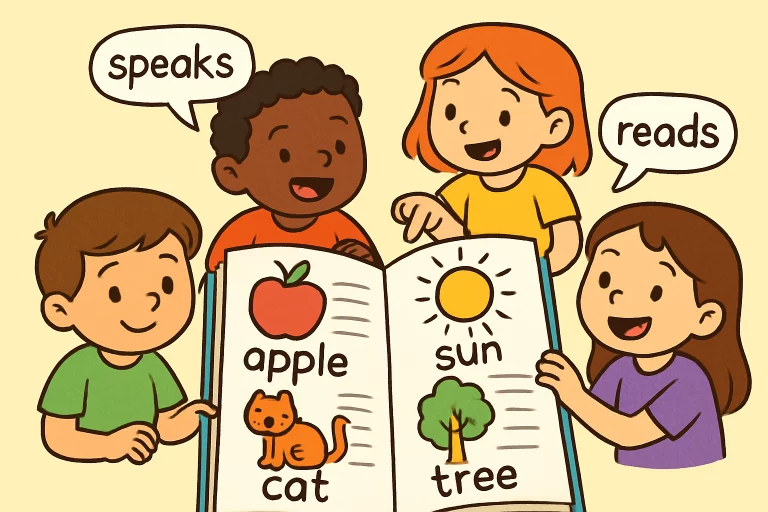Table of Contents
- Visual Engagement Captures Attention
- Enhancing Comprehension and Vocabulary
- Stimulating Imagination and Creativity
- Building Emotional Intelligence and Empathy
- Fostering a Love for Reading
- Supporting Multimodal Learning
- Encouraging Interactive Learning
- Conclusion
Visual Engagement Captures Attention
In today’s technology-driven environment, where distractions are constant and abundant, capturing and holding a child’s focus can be one of the most prominent challenges educators and parents face. Illustrated educational books have emerged as critical tools in this battle for attention, leveraging vibrant colors, engaging characters, and detailed scenes to spark curiosity from first glance. Dynamic visuals are not merely decorative—they are meticulously crafted to complement the text, providing immediate context and drawing readers into the material with visual storytelling. This merging of imagery and words drives the popularity of innovative educational tools, such as interactive board games, which seamlessly integrate engaging visuals to sustain attention during learning sessions.
Illustrated books benefit children who struggle with concentration or learn best through visual cues. Using vivid imagery can clarify new ideas, strengthen one’s understanding, encourage deeper exploration, and inspire more extended engagement with the subject matter. This heightened focus transforms reading from a passive activity into an active, enjoyable journey of discovery, making it a valuable tool for children who prefer visual aids.
Enhancing Comprehension and Vocabulary
Illustrated books are crucial for early literacy and language development. They provide visual support, making comprehension of new words and images instantaneous. For instance, a child reading about a “walrus” in an Arctic book can see a detailed picture of the animal, which helps cement the word’s meaning more effectively than through words alone. This visual support also helps children connect words and their real-world meanings, deepening contextual understanding. Repeated exposure to images paired with specific terms builds a stronger neural network for language acquisition, leading to quicker vocabulary recall and application. These foundational literacy experiences foster decoding skills, context clues, and inferencing abilities essential for lifelong literacy and academic achievement.
Stimulating Imagination and Creativity
Illustrated educational books are a powerful tool for children’s creative thinking and problem-solving. They provide imaginative experiences filled with whimsical landscapes, curious creatures, and imaginative adventures, igniting curiosity and sparking narrative invention. These books encourage children to think creatively, question “what if” and “why not,” and develop cognitive skills. They encourage children to create sequels, invent new characters, and engage in role-play scenarios, enhancing social and problem-solving abilities. The connection between art, story, and personal experience helps bridge the gap between abstract concepts and practical understanding. Exposure to these resources nurtures adaptable thinkers with lively imaginations and a genuine enthusiasm for learning.
Building Emotional Intelligence and Empathy
Illustrated educational books are essential for nurturing emotional intelligence in children. They provide expressive artwork that depicts various emotions, such as joy, frustration, worry, and excitement, allowing readers to “read” emotions visually. This is particularly important for younger children or those with limited verbal skills. Children learn to recognize similar emotions in themselves and their peers by encountering characters who navigate challenges and interact with others. This fosters empathy, as readers understand why a character might feel sad or how they can offer comfort. This practice increases self-awareness, improves emotional regulation, and strengthens social skills. Additionally, illustrated stories encourage children to share their feelings, laying the groundwork for meaningful relationships based on compassion and understanding.
Fostering a Love for Reading
Illustrated books impart knowledge and make reading an adventure, fostering excitement and curiosity in children. This early love for books extends beyond childhood, as children who grow up surrounded by visually appealing reading material are more likely to become independent, enthusiastic readers. They are motivated to seek out books for exploration, whether discovering distant lands, learning about different cultures, or delving into science and history. By nurturing curiosity and fostering a strong relationship with books, illustrated educational materials ensure that children are continually inspired to read and learn, shaping inquisitive minds for the future.
Supporting Multimodal Learning
Every child absorbs information differently, and illustrated educational books are designed to appeal to a diverse range of learning styles. By presenting information visually and textually—and often combining both with interactive experiences—these books empower children to use multiple senses as they learn. This multimodal approach, found in resources, has been proven to deepen engagement and boost retention of new concepts.
Research demonstrates that combining words and images activates more areas of a child’s brain than using one medium alone. Children who interact with various sensory inputs tend to understand and remember complex ideas more thoroughly. Multimodal learning accommodates different types of learners—visual, auditory, and kinesthetic—and ensures that knowledge is more easily transferred beyond the page, supporting real-world problem-solving and critical thinking. The integration of these various modes is at the forefront of modern educational theory.
Encouraging Interactive Learning
The evolution of illustrated educational books has seen a remarkable integration of technology and interactivity, making learning more engaging than ever. Many contemporary titles now feature flaps to explore, textures to feel, or digital enhancements like augmented reality (AR), inviting children to take an active role in their reading journey. Lifting a flap to discover hidden information or scanning a page with a tablet to see illustrations animate before their eyes transforms passive reading into active exploration.
These interactive features are more than just entertaining—they reinforce the learning process by linking hands-on activity to new knowledge, helping children internalize information. For today’s digital-native youth, such immersive educational experiences are not just appealing; they are often expected. As digital tools become more accessible and prevalent in classrooms and homes, technology within illustrated books will continue to grow, supporting creative, memorable, and dynamic learning environments for children of all ages. To access the latest innovative titles and ideas for interactive learning, parents and educators can turn to resources for inspiration and support.
Conclusion
Illustrated educational books are much more than a source of entertainment—they are foundational resources that engage, inspire, and educate on multiple levels. By skillfully blending vivid imagery with purposeful text and interactive elements, these books turn learning into an enriching, holistic experience. This integration empowers young readers to understand the world more deeply, nurture their creativity, develop social and emotional skills, and foster a lifelong love of reading. Educators and parents who incorporate illustrated books and complementary tools into their teaching strategies offer their children the greatest gift: the joy of discovery inside and outside the classroom.











